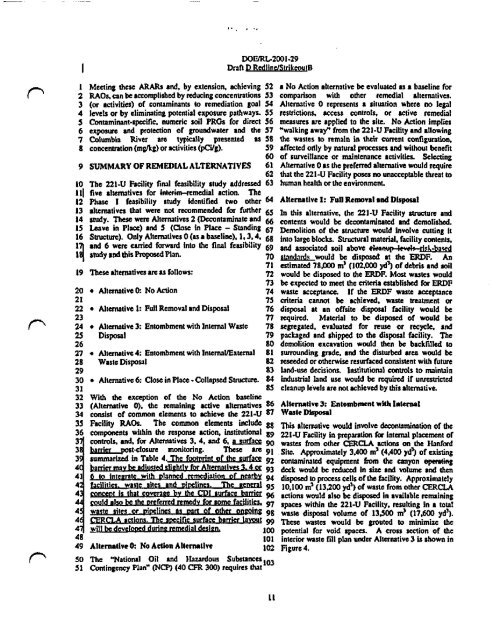View Document Here - Hanford Site
View Document Here - Hanford Site
View Document Here - Hanford Site
You also want an ePaper? Increase the reach of your titles
YUMPU automatically turns print PDFs into web optimized ePapers that Google loves.
^<br />
^<br />
I Meeting these ARARs and, by extension, achieving<br />
2 RAOs, can be accomplished by reducing concentrations<br />
3 (or activities) of contaminants to remediation goal<br />
4 levels or by eliminating potential exposure pathways.<br />
5 Contaminant-specific, numeric soil PROs for direct<br />
6 exposure and protection of groundwater and the<br />
7 Columbia River are typically presented as<br />
8 concentration (mg/kg) or activities (pCi/g).<br />
9 SUMMARY OF REMEDIAL ALTERNATIVES<br />
10 The 221-U Facility final feasibility study addressed<br />
llI five alternatives for interim-remedial action. The<br />
12 Phase I feasibility study Identified two other<br />
13 alternatives that were not recommended for further<br />
14 study. These were Alternatives 2 (Decontaminate and<br />
15 Leave in Place) and S(Close in Place - Standing<br />
16 Structure). Only Alteraatives 0 (as a baseline), 1. 3.4.<br />
1^ and 6 were carried forward into the final feasibility<br />
1 study and this Proposed Plan.<br />
19 These alternatives are as follows:<br />
20<br />
21<br />
22<br />
23<br />
24<br />
25<br />
26<br />
27<br />
28<br />
29<br />
30<br />
31<br />
32<br />
33<br />
34<br />
35<br />
36<br />
3<br />
3<br />
3<br />
4<br />
41<br />
4<br />
4<br />
4<br />
4<br />
48<br />
49<br />
• Alternative 0: No Action<br />
• Alternative 1: Full Removal and Disposal<br />
• Alternalive 3; Entombment with Internal Waste<br />
Disposal<br />
• Alternative 4: Entombment with InternaVExternal<br />
Waste Disposal<br />
• Alternative 6: Close in Place - Collapsed Structure.<br />
With the exception of the No Action baseline<br />
(Alternative 0), the remaining active alternatives<br />
consist of common elements to achieve the 221-U<br />
Facility RAOs. The common elements include<br />
components within the response action, in.aitutional<br />
rnntrols. and, for Alternatives 3, 4, and 6, a u a<br />
barrier nost-elosure monitoring. These are<br />
summarized in Table 4. The foomrint of the surface<br />
Alternative 0: No Action Alternalive<br />
DOFJRl.2001-29<br />
Draft D RedlindStrikeout D<br />
50 The "National Oil and Nazardous Subsunees103<br />
SI Contingency Plan" (NCP) (40 CFR 300) requires that<br />
52 a No Action alternative be evaluated as a baseline for<br />
53 comparison with other remedial alternatives.<br />
54 Alternative 0 represents a situation where no legal<br />
SS restricbons, access controls, or active remedial<br />
56 measures are applied to the site. No Action implies<br />
57 "walking away" from the 221-U Facility and allowing<br />
S8 the wastes to remain in their current configuration,<br />
59 affected otily by natural processes and without benefit<br />
60 of surveillance or maintenance acdvities. Selecting<br />
61 Ahernative 0 as the preferred alternative would require<br />
62 that the 221-U Facility poses no unacceptable threat to<br />
63 human health or the environment.<br />
64 Alternatlve 1: Full Removal and Disposal<br />
65 In this alternative, the 221-U Facility structure and<br />
66 contents would be decontaminated and demolished.<br />
67 Demolition of the structure would involve cutting it<br />
68 into large blocks. Structural material, facility contents.<br />
69 and associated soil above tieaoW>-leve{R-yj,l^y3gQ<br />
70 st,indards would be disposed at the ERDF. An<br />
71 estimated 78,OOD ms (102,000 yd) of debris and soil<br />
72 would be disposed to the ERDF. Most wastes would<br />
73 be expected to meet the criteria established for ERDF<br />
74 waste acceptance. If the ERDF waste acceptance<br />
75 criteria cannot be achieved, waste treatment or<br />
76 disposal at an offsite disposal facility would be<br />
77 required. Material to be disposed of would be<br />
78 segregated, evaluated for reuse or recycle, and<br />
79 packaged and shipped to the disposal facility. The<br />
80 demolition excavation would then be backfilled to<br />
81 surrounding grade, and the disturbed area would be<br />
82 reseeded or otherwise resurfaced consistent with future<br />
83 land-use decisions. Institutional controls to mainuin<br />
84 industrial land use would be required if unrestricted<br />
85 cleanup levels are not achieved by this alternative.<br />
86 Alternative 3: Entombment with Internal<br />
87 Waste Disposal<br />
88 This alternative would involve decontimination of the<br />
89 221-U Facility in preparation for intemal placement of<br />
90 wastes from other CERCLA actions on the Flanford<br />
91 <strong>Site</strong>. Approximately 3A00 ms (4A00 yds) of exi.sting<br />
92 contaminated equipment from the canyon eperating<br />
93 dcck would be reduced in size and volume and then<br />
94 disposed to process cells of the facility. Approximately<br />
95 10.100 ms (13.200 yds) of waste from other CERCLA<br />
96 actions would also be disposed in available remaining<br />
97 spaces within the 221-U Facility, resulting in a total<br />
98 waste disposal volume of 13500 tns (17.600 yd').<br />
99 These wastes would be grouted to minimize the<br />
100 potential for void spaces. A eross section of the<br />
101 interior waste fill plan under Alternative 3 is shown in<br />
102 Figure 4.<br />
11

















